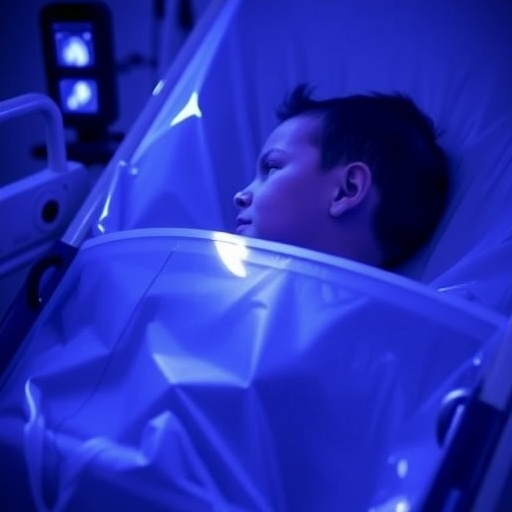
Credit: Image created by Scixel (http://scixel.es/), under the instructions of D. Luque and P. J. de Pablo.
Researchers have provided new insight on the mechanics of a virus that causes severe diarrhea and sickness in young children, according to a report published in eLife.
The study, from the Autonomous University of Madrid, Carlos III Health Institute and National Center for Biotechnology, Spain, could open up new avenues for developing effective treatments for rotavirus, which commonly infects children up to five years old. It is the first paper to detail the interplay between the function and mechanical properties of a 'multilayered' virus.
Virus particles enclose their genetic material in a protein shell designed to protect, shuttle and release its genome at the host cell. The structure of virus particles therefore need to be strong enough to protect the viral genome in environments outside the cell, and to withstand attacks from the host immune system, to ensure successful infection.
Many double-stranded RNA viruses, such as rotavirus, isolate their genome within a core shell that incorporates its own molecular machinery to allow the genome to replicate and spread. Some viruses take this a step further and build extra concentric protein layers that function in other ways, such as to help bind and penetrate their target cells.
"The complete particle of rotavirus is formed by three independent protein shells. This particle and the subviral particles containing one or two protein layers play distinct roles during infection," explains lead author Manuel Jiménez-Zaragoza, Research Assistant in the Department of Physics of Condensed Matter at the Autonomous University of Madrid. "We wanted to see how the interactions between the layers that define these different particles work together during the virus replication cycle."
Although previous studies have revealed how to purify two-layer protein particles, the authors of the current work have developed a novel way to purify single-layer particles, allowing them to be studied individually. After purifying these subviral particles, the team used a scanning probe system called atomic force microscopy, which involves using a small, sharp stylus to deform the virus particles. This allowed them to study the strength and stability of individual triple, double and single-layered particles.
They discovered a strong interaction between the external and middle layers, which they say is critical for the protection of the complete virus particle. Meanwhile, the interactions that take place between the middle and inner layers help the virus to replicate its genome among host cells, a process known as transcription.
"Our findings reveal how the biophysical properties of the three protein shells are fine-tuned to enable rotavirus to be carried among host cells," says senior author Pedro de Pablo, Associate Professor at the Autonomous University of Madrid. "We believe this could prove valuable in offering new venues for the development of novel antiviral strategies."
###
Reference
The paper 'Biophysical properties of single rotavirus particles account for the functions of protein shells in a multilayered virus' can be freely accessed online at https://doi.org/10.7554/eLife.37295. Contents, including text, figures and data, are free to reuse under a CC BY 4.0 license.
Media contact
Emily Packer, Senior Press Officer
eLife
[email protected]
01223 855373
About eLife
eLife aims to help scientists accelerate discovery by operating a platform for research communication that encourages and recognises the most responsible behaviours in science. We publish important research in all areas of the life and biomedical sciences, including Physics of Living Systems, which is selected and evaluated by working scientists and made freely available online without delay. eLife also invests in innovation through open-source tool development to accelerate research communication and discovery. Our work is guided by the communities we serve. eLife is supported by the Howard Hughes Medical Institute, the Max Planck Society, the Wellcome Trust and the Knut and Alice Wallenberg Foundation. Learn more at https://elifesciences.org/about.
To view the latest Physics of Living Systems research published in eLife, visit https://elifesciences.org/subjects/physics-living-systems.
Media Contact
Emily Packer
[email protected]
@elife
http://www.elifesciences.org
Original Source
https://elifesciences.org/for-the-press/2efd0153/new-insight-on-rotavirus-mechanics-could-lead-to-improved-treatments http://dx.doi.org/10.7554/eLife.37295





